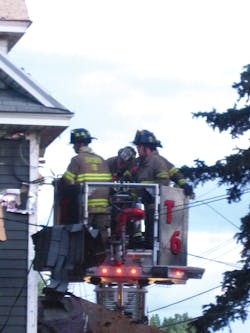As firefighters we consider the term engagement as our way to attack a fire, or to put a pump into gear. In this article, “engagement” is going to cover a different topic; we are going to discuss engaging firefighters in training. Creating a drill is considered challenging, whatever the topic there are several factors that must be considered while in the drafting and creating process. First to include are what topic or subtopics should be covered during the drill, what is the objective of the drill, and what are going to be the best ways to prepare and present the material?
Presenting the material in a manner from which all firefighters understand the objectives is a challenge. As an instructor, there are many times when I have attempted to cover a topic and all I get in return are blank stares, or guys staring off into space because they don’t understand the topic and want me to move on anyways. This is frustrating on a personal level, because I feel I have failed to instruct my firefighters. It also means for that particular section, or perhaps the whole drill, I didn’t encompass the learning styles of the group and didn’t include, or engage them, as needed.
Engagement in instruction is crucial in order for firefighters to retain what they are being presented. There are two forms of engagement that happen while teaching a drill and should be kept in mind when creating a drill. While sparing the long-winded definitions and clinical description of each, the shorthand are active engagement and passive engagement. To create drills that encompass these forms of engagement, the firefighters must be motivated to learn and not just be sitting in the drill for credit.
In general overviews, passive engagement is providing the learners with the information for them to ingest, and allowing them to personally comprehend the materials, while the instructor provides all the answers. Active engagement involves using the whole group to share information; leaving blanks in the information requiring people to answer questions, or building cues into the presentation that will either activate questions from you or from your audience. Both of these forms of engagement can be beneficial to use, however better results may be garnered from active engagement.
Both forms of engagement occur during the course of a lesson. There will be many times that passive engagement will occur because of the topic and the fact that people may not have a strong background. So don’t get down if many times firefighters are silent and listening, as many times that is a good thing. Other times, active engagement will occur and it is a good way to measure if you are connecting to the firefighters. You will know you are engaging them if they are asking appropriate questions, and showing their understanding in discussion.
Using active engagement creates motivation for the learners in the room to be involved and participate. Some of this motivation may be that they have reached an engagement level they are comfortable with and are willing to share, while others may participate out of fear of being called on or later asked to contribute on a topic their background is weak in. While these two motivations are along the lines of self preservation and comfort, they both engage the learner and make them become involved in the presentation. A learner that is engaged is more likely to retain the information presented, unlike a person who is disinterested and unengaged entirely.
Having described the two forms of engagement, many may now be wondering what can be done in order to create active engagement in a drill. For active engagement to increase, the learning styles of the people present must be met. Learning styles are different than teaching styles in that teaching styles fall into categories of how to teach material, which can cover many methods. Learning styles generally fall into three categories, visual, audio and kinesthetic learners; each individual can fit into either one or more of the categories.
Visual learners are those learners who need to see how something is done in order to understand what they are being taught. However, it isn’t as easy as it sounds. Putting a picture of the entire concept in front of a visual learner isn’t effective because there is minimal engagement, passive or active. They need a series of pictures like a step-by-step guide, or a live presentation to truly learn what is being done. This learning style is best accommodated with either pictures, video clips or with a hands-on demonstration.
Auditory learners learn best by hearing. Straight forward lecturing to audio learners isn’t an effective method; the engagement in learning isn’t there. Auditory learners can benefit from a step-by-step auditory lesson for them to learn. Discussion, in depth-description and group sharing are good ways to accommodate those with this learning style.
Kinesthetic learners are people who learn best with their hands. Kinesthetic learners, much like audio and visual, will learn over time through other means, but their engagement comes from doing what is being taught. Many times a kinesthetic learner will need to take the equipment being discussed in their hands and learn by doing so that they are engaged, sometimes a challenging feat for an instructor. A way to accommodate this learning style is to break up a drill into part lecture and part hands on.
An example of a drill using active engagement and including all three learning styles would be practicing a hose stretch then cracking open the line and putting a knock on a fire. While demonstrating physically what you want the participants to do, you are able to show the visual learners, and describe to the audio learners, while the kinesthetic observe both. When the drill begins and is in action, you will cover your kinesthetic learners, by getting them involved.
An engaging drill has multiple parts, and takes a large amount of prep work ahead of time. It is rewarding as an instructor when you are able to see the engagement and the understanding in the actions of your firefighters. Passive and active engagement occurs throughout the lesson, but needs to be controlled so as not to bore everyone at the drill. To achieve both kinds of engagement, an instructor must cover the three learning styles. The key to attaining both passive and active engagement is when you have the direct attention of one learning style (doing a visual demonstration is active engagement for visual learners, but passive for auditory and kinesthetic) and are able to passively engage the others. This will allow for more firefighters to learn from the drill, and get better results at the end.
A question for the readers, what do you do in your departments that cover this kind of topic? What drills do you hold that seem to be the most popular, or the least popular? If you have questions or would like feedback, feel free to contact me at [email protected].
SEAN WILKINSON is a captain and drill instructor with the Snyder Fire Department in Amherst, NY. He is a police dispatcher for the Town of Amherst Police and is the manager of an Urgent Care Center. He has a Bachelors of Arts in History from the University at Buffalo, and is currently completing the requirements for his Masters in Secondary Education at the University at Buffalo.

Sean Wilkinson
Sean Wilkinson is a former Captain and Training officer with the Snyder Fire Department. He has a background in secondary education, and a history degree from the University at Buffalo. He can be reached at [email protected].






